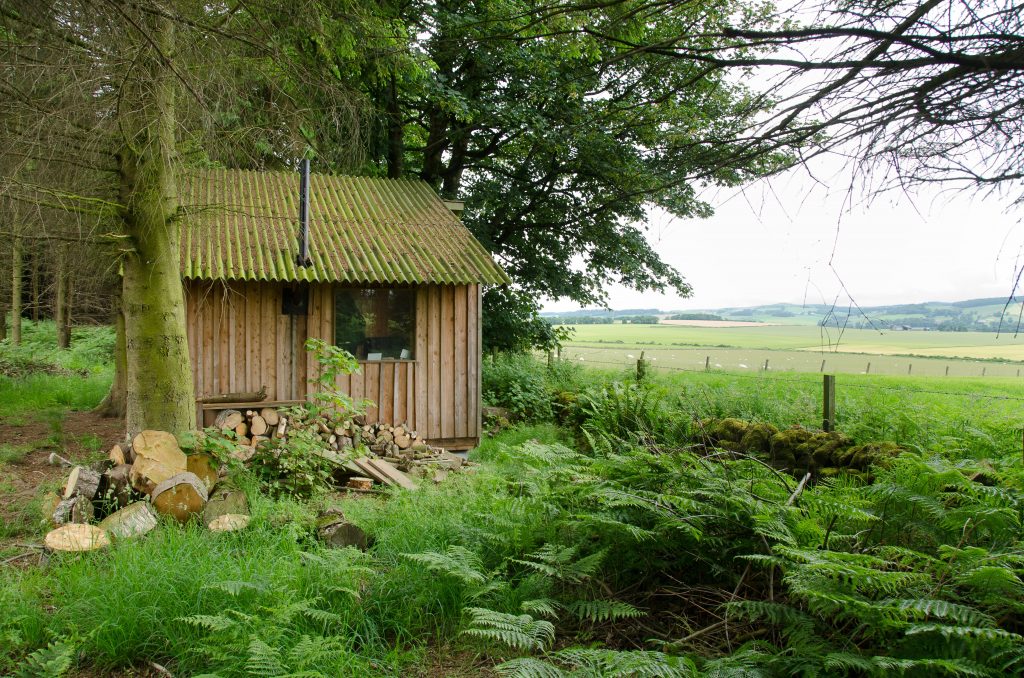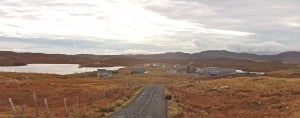It’s a simple concept: a little hut in the woods; a place to spend some time outdoors; reconnect with the real world. There are hytte all over Scandinavia and northern Europe, so why not here?
It’s a simple building: made from local timber; maybe self-built; easily removed at the end of its life.
And it’s one simple step to create the policy framework: add a concise definition of a hut to Scottish Planning Policy and watch the verbose hutting movement take physical form.
Off we go then.  We recently submitted a planning application for a pilot project by Reforesting Scotland, the group that’s done more than anyone to promote hutting in Scotland, through its 1000 Huts Campaign. Working with Forestry Commission Scotland on a site at Carnock Wood by Saline in Fife, Reforesting Scotland plans 13 huts, one of which is intended for educational use.
We recently submitted a planning application for a pilot project by Reforesting Scotland, the group that’s done more than anyone to promote hutting in Scotland, through its 1000 Huts Campaign. Working with Forestry Commission Scotland on a site at Carnock Wood by Saline in Fife, Reforesting Scotland plans 13 huts, one of which is intended for educational use.
We’ve tried to keep it simple. We helped Reforesting Scotland set out information for this kind of development in their guidance for “New Hutting Developments”, published in 2016. We’ve now sought to create a template through this planning application to make it easier for others to follow. The application documents can be viewed here.
A quick look at the application file online and you’ll realise that simplicity only goes so far. The planning system hasn’t handled many hutting applications in recent years, as there are so few huts in Scotland and barely any have been built in recent times. Planning authorities need to be confident that they aren’t opening the door to inappropriate development. They want to know what the huts will look like. They want to know about any potential impacts on ancient woodland, habitat and protected species, road safety and landscape setting, flooding and core paths. They want to know how people will travel to the huts, how they will use them, how the site will be managed.
Sometime soon, a simpler planning application process may be possible. Once a body of hutting evidence has emerged, we can all campaign for a lighter-touch approach to the planning process, for this lighter-touch form of development. If Simplified Planning Zones are acceptable for housing and employment, then why not huts?
For now, this seems like a big step forward. There’s more work to be done but the planning application takes us closer to making huts available for people who want them. And we know lots of people want them….
Archive | rural
Land Reform In One Easy SLUP
 We’re working with Falkland Estate in Fife – home of the Centre for Stewardship – on estate visioning and master planning. Today we helped host a visit from the Scottish Government’s Rural Affairs, Climate Change and Environment committee (RACCE). The visit was part of the committee’s land reform fact-finding tour, which is working its way around the country. In a brief presentation, we explained the importance of long term spatial planning and visioning for estates and large land holdings or sites.
We’re working with Falkland Estate in Fife – home of the Centre for Stewardship – on estate visioning and master planning. Today we helped host a visit from the Scottish Government’s Rural Affairs, Climate Change and Environment committee (RACCE). The visit was part of the committee’s land reform fact-finding tour, which is working its way around the country. In a brief presentation, we explained the importance of long term spatial planning and visioning for estates and large land holdings or sites.
At Falkland, we’re effectively merging the PAN 83 urban master planning model we’ve applied for private estates at Bowmore, Inveraray and Forres recently, with the feasibility model for community land ownership studies at Culbokie, Lochmaddy and Great Bernera (working with Dr Calum MacLeod’s team).
The aim is to facilitate sustainable land management. The model works for both private and community land ownership. It’s as good an indication as any that the landowner is committed to sustainable use of the land.
These days, there’s a statutory requirement for major planning applications to be accompanied by a Design Statement (see PAN 68). Quality of place is a high priority for the Scottish Government, with cross-party support. The requirement for a Design Statement reflects this. It’s still disappointing that many Design Statements are accepted by planning authorities despite being half-hearted box-ticking exercises, but that’s another blog….
Like quality of place, the Scottish Government has made land reform a priority. Again, there’s broad cross-party support (with the exception of the Conservatives, who take a more cautious position). One aspect of the current Land Reform (Scotland) Bill 2015, is the contentious matter of sustainable land use and the potential for communities to be granted rights to purchase land which is not being used sustainably.
At this stage, it’s unclear what that means. What mechanisms might the Scottish Government apply to define sustainable land use? How might land owners illustrate a commitment to sustainable use? If a Design Statement proves a commitment to quality place making, could an estate master plan or vision do the same for sustainable land use?
We think so.
A document similar to PAN 68 could set out advice on preparing a Sustainable Land Use Plan (SLUP!) and encourage land owners to follow best practice and prepare their own. The forthcoming Land Reform (Scotland) Act could explain the scenarios where the proposed Scottish Land Commission might request a SLUP as evidence of effective land management.
There’s an obvious resource issue in rolling out this kind of study but our experience suggests that it proves cost effective by unearthing investment opportunities, financial efficiencies and greatly enhanced relationships with stakeholders and communities. That applies to land in private or community ownership.
Land reform may be a polarising issue, but most people seem to agree that sustainable land use is a valid ambition. A tool like SLUP can add value across the spectrum. Why wouldn’t we use it?
